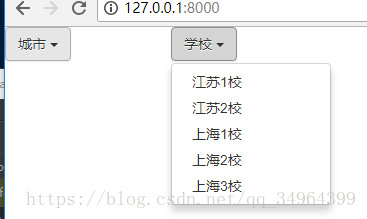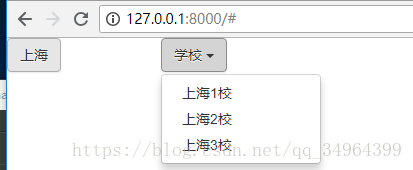
As shown in the figure, click a city to display the corresponding school name. At first, I thought it was implemented when I built the data table, but it was implemented through ajax.
Idea: when the get request shows the original state (that is, the drop-down box presents the whole content). After clicking a city, submit it through ajax post, and then the back-end returns the filtered data to the front-end. Then js first deletes all the school labels and creates the school labels from the back-end
views.py
class IndexView(View):
def get(self,request):
citys = City.objects.all()
schools = School.objects.all()
return render(request,'index.html',{
'citys':citys,
'schools':schools,
})
def post(self,request):
selectCity = request.POST.get('selectVal')
schools = City.objects.get(name=selectCity).school_set.all()
schoolLists = [ obj.name for obj in schools]
schoolDict = dict(zip(schoolLists,schoolLists))
print(schoolLists)
return HttpResponse(json.dumps(schoolDict))
Front end
$("#city ul li").on('click',function () {
var selectVal = $(this).text();
$("#city button:first").text(selectVal);
$.ajax({
type:'POST',
url:"{% url 'index' %}",
data:{'selectVal':selectVal},
success:function(data) {
var len = $("#school li a").length;
for(var i=0;i<len;i++){
$("#school li a").eq(0).remove();
}
ret = JSON.parse(data);
for (var obj in ret) {
$("#school ul").append("<li><a>"+ obj +"</a></li>");
}
}
})
});
The front-end html file is bootstrap, which is roughly
<div id="school" class="dropdown" style="float:left;margin-left:100px">
<button id="i1" class="btn btn-default dropdown-toggle" type="button" id="dropdownMenu1" data-toggle="dropdown" aria-haspopup="true" aria-expanded="true">
//School
<span class="caret"></span>
</button>
<ul class="dropdown-menu" aria-labelledby="dropdownMenu1">
{% for obj in schools %}
<li><a href="#" data-value="{{ obj.name }}">{{ obj.name }}</a></li>
{% endfor %}
</ul>
</div>
</div>
In this way, you can choose.

2. The following is to realize tag linkage in xadmin, all according to https://blog.csdn.net/qq_16102629/article/details/81179250 Made
The difficulty is how to introduce the custom js file into the registered model.
models.py
class Student(models.Model):
name = models.CharField(max_length=10,verbose_name=u'Full name',null=True,blank=True)
school = models.ForeignKey(School,verbose_name=u'Student's school',null=True,blank=True)
city = models.ForeignKey(City,verbose_name=u'Student city',null=True,blank=True)
class Meta:
verbose_name = u'Student'
verbose_name_plural = verbose_name
def __str__(self):
return self.name
The customized xadmin.js (name is optional) file is put into extra app / xadmin / static / xadmin / JS, and then the customized xadmin.js file is added in extra app / xadmin / widgets.py. ID city and ID School of JS can be found from the page


$('#id_city').change(function () {
var module = $('#id_city').find('option:selected').val(); / / get the parent selected value
$('#ID [school ') [0]. Select. Clearoptions(); / / clear child level
$.ajax({
type: 'get',
url: '/select/city_school/?module=' + module,
data: '',
async: true,
beforeSend: function (xhr, settings) {
xhr.setRequestHeader('X-CSRFToken', '{{ csrf_token }}')
},
success: function (data) {
data = JSON.parse(data.schools)//Convert JSON
console.log(data);
for (var i = 0; i < data.length; i++) {
var test = {text: data[i].fields.name, value: data[i].pk, $order: i + 1}; //Traverse the data and put together the format needed by select
console.log(test);
$('#ID [school ') [0]. Select. Addoption (test); / / add data
}
},
error: function (xhr, textStatus) {
console.log('error')
}
})
})
Next, the view function
urlpatterns = [
url(r'select/city_school/',SelectView.as_view(),name='city_school'),
]
from django.core import serializers
class SelectView(View):
def get(self,request):
print("asd")
city_id = request.GET.get('module','')
schools = serializers.serialize("json", School.objects.filter(school_city_id=int(city_id)))
print(schools)
# Judge whether it exists, output
if schools:
return JsonResponse({'schools': schools})